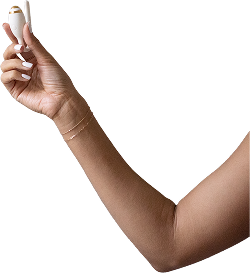From a glance:
- Mira tracks urine metabolites to predict ovulation
- The Mira user is required to use multiple ‘plus wands’ per cycle (dependent on cycle length) 1-2 times per day
- kegg tracks the changes in cervical fluid to predict and show the full fertile window.
- kegg is used one time a day for 2 minutes
- The kegg user can see their fertile window open and progress in real-time to ensure they are optimally timing their TTC efforts.
- kegg is a one time investment: there are no recurring costs, wands, or subscription fees
- Average monthly cost of Mira wands per 28 day cycle is $93.25 (analyzer not included-$199)
- Total cost when trying to get pregnant for 6 months
- Mira – ~$550
-
kegg – $259
Mira: Urine metabolite tracker
- Mira is a fertility tracking system that uses urine metabolites to monitor the user’s fertility status.
- It includes a small handheld analyzer, access to the Mira app, and requires single-use urine test sticks.
- The Mira fertility sticks or “plus wands” are used for tracking the urine metabolites of Estradiol and Luteinizing Hormone to predict when the user is likely fertile or not.
- Confirm wands are also used to track progesterone metabolites.
How Mira works
kegg: Cervical Mucus tracker
- kegg is a small, sleek fertility tracker which senses cervical fluid (and its electrolyte levels) to predict the full fertile window.
- In 2-minutes a day, the user gains insight into her cycle, by watching the trend of the daily readings, and seeing the predicted fertility status, all displayed in the kegg app.
- As the user enters the fertile window, the kegg readings will descend on the y-axis due to the increasingly more hospitable vaginal environment and rising estrogen.
- The kegg user inputs their periods, and has the option to enter other information, such as cervical mucus observations, temperature, LH, PdG, and hCG tests. These optional items do not influence the algorithm.
How kegg works:
My experience with Mira

I also did not find that my Mira results were insightful when it comes to knowing my most fertile days. For example, even though I could see my estrogen rising, I did not know when my LH would surge relative to this, making the fertile window prediction feel like a guess at best. With kegg, I am very familiar with my “drop” in kegg readings that typically lasts 4 to 5 days. When I see my descending values, I can confidently assume I am in my fertile window. Of course, the added fertile window prediction provided by kegg gives me added confidence of my timing.
The displays
While both kegg and Mira provide graphs of results, I found the kegg app colors and trend line easier on my eyes. The y-axis on the Mira graphs is hard to read and the results are plotted with a thin line. Especially when tracking multiple hormones, these thin, light lines are difficult to discern. kegg on the other hand uses the readings in small circles with a dark, very evident trendline that is easy to spot.

Both Mira’s and kegg’s algorithms need to learn about your cycles. Since Mira uses single-use test wands, I felt like the app should have communicated more precisely when I needed to use the Plus wands a second time in a day. Mira fertility wands are quite expensive each cycle and can’t be bought in box stores so I didn’t want to use more than needed. Users with cycles longer than 28 days or irregular cycles will often need more than the 10-15 Plus wands in a cycle.
My assumption was progesterone wands would be optional and used after an LH surge was detected, as testing for the progesterone metabolites before or during your fertile window will not aid in the prediction of ovulation tracking. This is not the case. Ever since Mira updated their app in September, 2021 the Confirm wands have been pushed every cycle day. Upon first opening the app I was asked to test with a Confirm Wand or instructed to purchase them. While the use of the Confirm Wands is still optional (at this time), many users will likely assume they’re missing out on necessary data and feel they are not doing all that they can to accurately track their fertility.
I stopped using Mira after 2 cycles because the cost was exuberant and the insights weren’t anything new. Unfortunately, the cost of the analyzer is expensive so I feel the investment was not worthwhile.

The benefits of Mira
Mira has a TTA (trying to avoid or postpone pregnancy) profile setting that so far looks and acts the same as the TTC setting. Mira promotes itself as a useful tool to be used alongside NFP (Natural Family Planning). I have read through Mira’s TTA information and it seems mucus tracking and/or temperature tracking is still needed. Mira warns on their website that “no fertility tracker is approved by the FDA as a 100% sure-proof contraceptive.” When you consider the cost, especially over years of use, I would not want to use or recommend Mira for avoiding or postponing pregnancy, especially for a long period of time. When considering it would cost, at minimum $901 a year (at the time of this writing), and still require additional tracking means, I was astonished.
kegg is not recommended as a contraceptive device but it can be used as a complementary tool to your preferred fertility awareness-based method (FABM), without any recurring costs.
I did find it intriguing and motivating that Mira displays numeric values for the metabolite levels it detects in urine. I think this could yield interesting cycle comparison data. I do feel, however, that urine concentration plays a significant role in the accuracy of the results. From years of tracking various forms of fertility data, I have learned that I do not capture a surge in LH with first morning urine, and instead see the surge later in the day. In fact, many women will not be able to detect an LH surge until later on, usually between 10 AM to 2 PM so I question why Mira recommends first morning urine and how many users might “miss” this surge when following their instructions for testing. My best guess is that consistent hydration/concentration of urine is needed for accurate results. This is something to keep in mind if you drink water overnight or need to use the bathroom in the early morning hours.
Mira states that it can be used for women with PCOS and irregular cycles. According to their website, users with irregular cycles may need to test more frequently to “find your ovulation”. This is concerning to me, as I already felt there was a substantial cost associated with a “typical” 28-day cycle, so for users with lengthy cycles, the cost could be astronomical. Comparatively, many women with PCOS are successful with kegg and are able to watch their trendline to identify the fertile valley(s). kegg provides fertile window predictions for users with cycles 21-40 days in length, but all users can see their daily readings and watch the overall trend to confidently time their efforts during the valleys.




